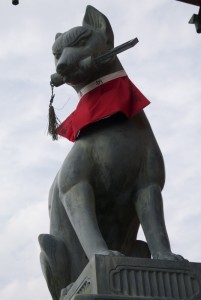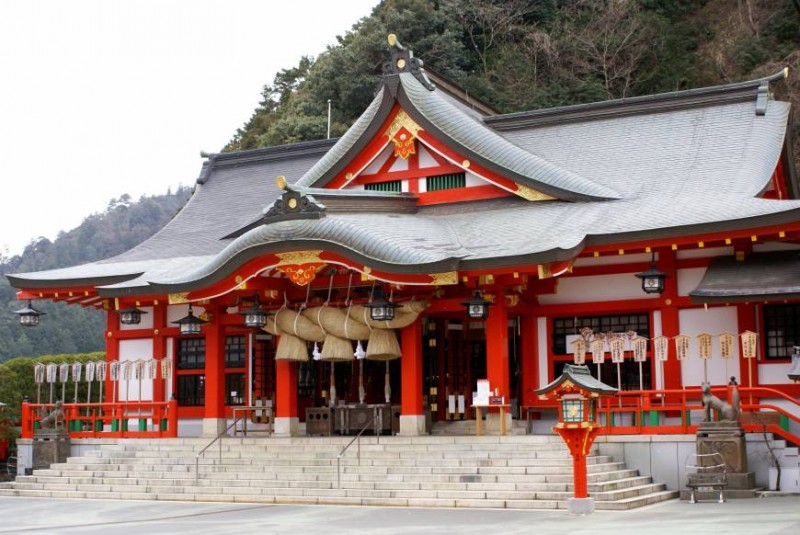Taikodani Inari Shrine is located in Tsuwano, near the western end of Honshu. It is one of the leading Inari shrines, of which Wikipedia has this to say: “According to a 1985 survey, 32,000 shrines — more than one-third of Shinto shrines in Japan — are dedicated to Inari. This number includes only Shinto shrines with full-time resident priests; if small roadside or field shrines, shrines kept in a home or corporate office, smaller shrines without full-time resident priests, and Buddhist temples were included, the number would increase by at least an order of magnitude.”
*****************
Warming to Tsuwano: a wintry visit to the town of fish and foxes
by Mandy Bartok Special To The Japan Times Jan 2, 2016
The first official gate to the Taikodani Inari Shrine sits at the turn-off to tiny Tsuwano from the circuitous mountain highway that links Yamaguchi and Shimane prefectures. The shrine’s main hall, however, sits on another peak halfway across town, a good five-minute drive away.

Kitsune, the fox guardian of Inari shrines,
I let my car idle at the traffic lights near the valley floor, conferring with my travel companion, Elaine, as to our next move. While the town to our right begs us to walk its lantern-lined streets, the threatening clouds above — a complete surprise in the forecast — encourage us to make the final ascent up to the main parking area of Taikodani.
I’d imagined that one of Japan’s five most important Inari shrines would have more than just us as its visitors, since it annually attracts around 1 million people. Today, however, the grounds are completely devoid of worshippers. The silence is punctuated only by the snapping of flags as the standards lining the shrine’s perimeter dance crazily in the strong wind.
Trying to ignore the scattering of snowflakes swirling through the air, I approach the only other beings in the complex — a pair of miko-san (shrine maidens) ensconced in a vestibule that doubles as a gift shop. They smile at my request for more information and happily dig up a photocopied English pamphlet.
My 4-year-old daughter darts around counting statues of foxes — the messengers of the goddess Inari — while I learn that in 1773, the local lord summoned the deities from Fushimi Inari Taisha in Kyoto to come reside in Tsuwano. The shrine became the personal prayer locale of the castle residents and even witnessed the 1924 visit of a princess of the Imperial family.
As we wander the grounds, I’m rather surprised that, for a three-century-old complex, Taikodani Inari Shrine fairly glows. “It was retouched about two years ago,” smiles the younger miko-san. The vermilion buildings would be striking on a normal day, but they seem even brighter now as the white snow gathers in clumps in the railings. What had begun as a gentle early winter squall is now turning into a storm with accumulation.
Out the side of the complex, a tunnel of 1,045 torii gates leads down the mountain, interrupted every few meters by a decorative lantern. We venture part of the way down the slope, before the white-out in the valley below forces us to beat a hasty retreat back to our car at the peak. The road back down the mountain remains black and passable, but my wipers do a steady business of pushing the flakes into fluffy hills on either side of my windshield.
Down on Tsuwano’s main street, we pull off in a lot just past the river and suffer a cold stroll down part of the town’s historic district of Tonomachi. Old white-washed buildings offer glimpses through their wooden entry gates of gnarled pines and well-trod stepping stones. Small water channels run along the edges of the street, replete with orange, white and spotted carp. Allegedly, Tsuwano has more fish than people, though neither they nor the citizens are out in force today. At the end of the street, a pair of statues commemorates Tsuwano’s annual Sagimai festival, where two performers dressed as male and female herons re-enact one of the country’s most traditional dances.
********************
Getting there: Tsuwano can be reached on the local JR Yamaguchi Line from Yamaguchi (72 minutes, ¥970). The Taikodani Inari Shrine is a 15- to 20-minute walk from Tsuwano Station to the bottom of the torii tunnel; a further 15-minute climb through the gates takes you to the main hall.



Leave a Reply